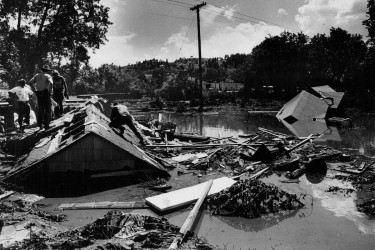Fifty years ago, Wounded Knee again became the setting for a confrontation between the U.S. government and a nascent movement of Indigenous resistance. Early in 1973, a local group called the Oglala Sioux Civil Rights Organization (OSCRO) came together to protest the corruption of Dick Wilson, a despotic tribal president. Wilson had recruited a private police force, known as the “goon squad,” which collaborated with the F.B.I. to intimidate his political opposition. A year into his tenure, four impeachment petitions had been brought against Wilson by Oglala Sioux tribal members for circumventing normal council procedures and siphoning tribal funds for his own use. But Wilson oversaw his own impeachment hearings, and avoided a real airing of his misdeeds.
The members of OSCRO turned to the American Indian Movement for help. “We decided that we did need the American Indian Movement in here because our men were scared, they hung to the back,” Ellen Moves Camp, a community-health representative and Oglala leader who lost her job for opposing Wilson, said. AIM, which was founded in Minneapolis, in 1968, had grown from a community-patrol outfit into a national organization pressing for federal recognition of treaty rights and American Indian sovereignty. The movement had drawn national attention by staging occupations of several regional Bureau of Indian Affairs headquarters, by confronting off-reservation vigilante violence against Native people, and by organizing the cross-country Trail of Broken Treaties, in 1972.
Wilson had banned all AIM activity, real or imagined, in Pine Ridge, going so far as to outlaw large public gatherings. OSCRO invited AIM anyway, and at a meeting on February 27, 1973, the AIM leaders Russell Means, Dennis Banks, and Clyde Bellecourt joined hundreds of others at a community hall on the reservation. There, they discussed staging a symbolic liberation of Wounded Knee, with the idea of reasserting the Lakotas’ traditional system of governance, based on the word of elders and the consensus of treaty councils rather than the rule of a single leader like Wilson. “And when we kept talking about it,” Moves Camp explained, “then the chiefs said, ‘Go ahead and do it, go to Wounded Knee.’ ” A fifty-four-car caravan carrying entire Native families and armed protesters drove past tribal headquarters, to a small village, situated in the hills where the 1890 massacre took place.












